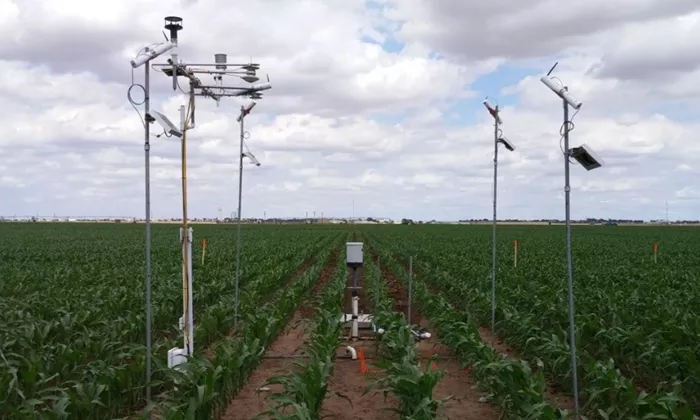USDA Scientists Use Weighing Lysimeters to Optimize Crop Water Use.
In Bushland, Texas, a team of scientists from the U.S. Department of Agriculture (USDA) Agricultural Research Service is harnessing the power of massive containers filled with soil to better understand crop water usage. These containers, known as weighing lysimeters, can hold over 85,000 pounds of soil and are helping researchers provide accurate irrigation recommendations for farmers.
Currently, four lysimeters are situated in a 48-acre field at the USDA Agricultural Research Station’s Conservation and Production Research Laboratory. Constructed in the late 1980s, these containers were initially intended for a decade of research aimed at developing regional crop coefficients. These coefficients estimate the water requirements of various crops based on weather conditions. Today, researchers continue to grow crops inside and around the lysimeters, measuring numerous climate and agronomic factors, with a focus on crop water consumption.
Each lysimeter measures 10 feet by 10 feet and is 8 feet deep. They sit on scales that monitor the total mass of soil and plants over time. This includes water added through irrigation or rainfall, as well as the water lost through a process known as evapotranspiration, where plants return water to the atmosphere. By tracking changes in mass throughout the growing season, scientists can accurately assess how much water crops need.
Gary Marek, a research agricultural engineer at the Soil and Water Management Research Unit in Bushland, explains that many farmers currently rely on soil water sensors to monitor crop water use. However, he notes that these sensors vary in complexity. Some are difficult to interpret, while others may yield inaccurate results. “Many sensors can give you an indication of whether you’re low or high on soil water,” Marek said, but “precision scheduling is challenging.”
Accuracy in water management is crucial. Underestimating water needs can lead to reduced crop yields or even crop death, while overestimating can deplete vital resources and increase costs for farmers.
With 40 years of data on nine different crops, the lysimeters provide highly accurate water usage data. Marek stated, “We measure a suite of parameters – everything you’d want to know agronomically.”
Initially, researchers used the lysimeters to compare crop water use under dryland and sprinkler irrigation systems. Currently, they focus on comparing different irrigation methods, particularly sub-surface drip irrigation and sprinkler systems. Since 2013, they have found that crops using sub-surface drip irrigation consume up to five inches less water than those using sprinkler systems, all while maintaining or sometimes increasing yields. This method minimizes surface wetting, reducing both evaporation loss and weed growth.
Additionally, researchers are comparing evapotranspiration measurements from the lysimeters with estimates obtained from an eddy covariance system, a tool that takes frequent meteorological measurements. Findings indicate that the eddy covariance systems often underestimate daily evapotranspiration by over 20 percent, underscoring the need for improved accuracy in other estimation systems. This raises concerns about current satellite-based evapotranspiration estimates, which are primarily based on eddy covariance data and may also be underestimating actual water usage.
While the Bushland lysimeters are not the only ones in operation, Marek asserts they are among the largest and best-maintained in the country. In the future, he and his team plan to explore the application of lysimeter data to limited irrigation for forage crops, particularly alfalfa. As drought conditions intensify and water availability diminishes, local dairy and cattle producers are seeking ways to grow forage crops without relying on water-intensive imports.
Marek emphasized the ultimate goal of their research: “Our main goal is to help the farmer maintain profitability as our water resources decline. Many people are faced with the decision of how to continue farming in these challenging conditions.”
Related topics:
- Study Reveals Plants Conserve Energy While Absorbing Potassium
- Protect Your Gardens and Plants from Freezing Winter Nights
- Gardeners Urged to Relocate This Flower Before It’s Too Late


